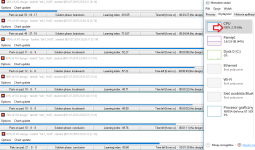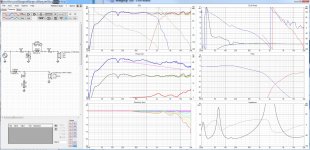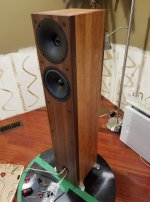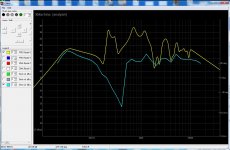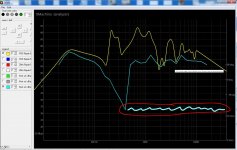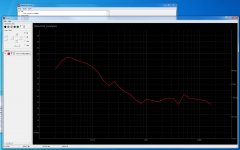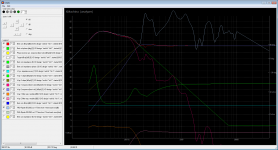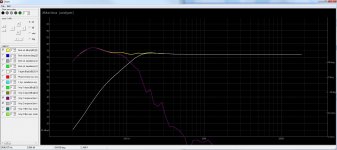Just finally tried XMachina for the first time and am quite intrigued! Thank you for the effort.
One question: how do you add drivers in series or parallel? Couldn't find that in the manual.
Best regards, G
In XMachina the rule is: one filter per one way (frd&zma set). Currently there is no other method to connect two speakers to one filter but providing frd/zma measurements in appropriate speakers connection.
Your CPU is 8-core I guess. XMachina is a single-threaded application hence 100%/8 = 12.5%
Actually it's possible to utilize other cores, just run few instances of XMachina in parallel to get several solutions in the same time (but remember to create separate copy of the design file for each instance).
Actually it's possible to utilize other cores, just run few instances of XMachina in parallel to get several solutions in the same time (but remember to create separate copy of the design file for each instance).
New version of XMachina [1190701] can benefit from multi-core architecture of a PC system. Usually, when working with XMachina, it is configured to deliver several solutions. They can be designed in the same time by different instances of XMachina working simultaneously on different cores.
It was also possible with the previous versions but it was required that each instance of XMachina had it's own copy of the design file. Keeping control over design when the data is spread on (for example) 8 files was problematic.
The problem is eliminated in the new version. Introduction of storage mediator allows that many instances of XMachina can write to the same design file.
To benefit from parallel processing with XMachina_v[1190701], follow these easy steps:
- crate a design task and save the design file,
- start the design,
- start a new instance of XMachina, open the same design file and start the design,
- repeat the last point several times (but avoid starting more instances of XMachina than number of cores in your system),
- when all the instances are finished with their processing close most of the instances leaving only one,
- reopen the design file choosing the first position from the "File/recent" submenu,
- expand the "Crossover designs" node to see all the designs.
Attached: XMachina utilizing 100% of an 8-core CPU for designing several solutions for the same task:
It was also possible with the previous versions but it was required that each instance of XMachina had it's own copy of the design file. Keeping control over design when the data is spread on (for example) 8 files was problematic.
The problem is eliminated in the new version. Introduction of storage mediator allows that many instances of XMachina can write to the same design file.
To benefit from parallel processing with XMachina_v[1190701], follow these easy steps:
- crate a design task and save the design file,
- start the design,
- start a new instance of XMachina, open the same design file and start the design,
- repeat the last point several times (but avoid starting more instances of XMachina than number of cores in your system),
- when all the instances are finished with their processing close most of the instances leaving only one,
- reopen the design file choosing the first position from the "File/recent" submenu,
- expand the "Crossover designs" node to see all the designs.
Attached: XMachina utilizing 100% of an 8-core CPU for designing several solutions for the same task:
Attachments
The "number of cores" should be actually understood here as the number of physical cores. I've been playing with the parallel designing feature for a while and I've noticed that starting more instances than the number of physical cores slows down previous instances noticeably. The number of cores shown in the task manager window could the number of logical cores, that is 2 times nr of physical cores, if the HT technology is implemented in the CPU. HT can be ineffective with XMachina.- start a new instance of XMachina, open the same design file and start the design,
- repeat the last point several times (but avoid starting more instances of XMachina than number of cores in your system),
Here is what I found on this subject and I don't think there is something I could do.
WS.Reputation.1 | Symantec
You do some network calls though right?! For stats or something?
Btw super cool app!
I might be stupid on the XO design but Im good on genetic algorithms so I can play with it for days and then do my manual work.
I assume its some sort or evolutionary process going on, also evident from the naming of the settings right?
Thanks super cool!
You deserve more credit.
Awesome application of neural networks...
I hope to try that pretty soon
Awesome app for sure, but I don't think is neural base. Not even reinforcement learning or something.
I see it as a 'genetic / evolutionary algorithm'.
Last edited:
Here is what I found on this subject and I don't think there is something I could do.
WS.Reputation.1 | Symantec
You do some network calls though right?! For stats or something?
As it's written in the "manual", XMachina reads the latest release version number from the home page XMachina. Then it compares it with it's own version id and, if it's older, the 'new-version-is-available' message is displayed. XMachina doesn't upload anything. No automatic updates with XMachina. Even the 'new-version-is-available' feature can be turned off in the environment settings.
Awesome application of neural networks...
Awesome app for sure, but I don't think is neural base. Not even reinforcement learning or something.
I see it as a 'genetic / evolutionary algorithm'.
It was already mentioned earlier in this thread the 'machine learning' term may be a bit misleading with reference to XMachina. It's better to call it an optimization algorithm as it's optimizing the "learning index" for the task. Is it an evolutionary algorithm - I wouldn't say so, maybe only in that narrow sense that it is slow and it's more like evolution than revolution
In fact, playing and experimenting with XMachina is equal fun as designing circuits to implement. I set weird tasks, even those that don't make much sense in audio technology: V-shaped fr? double stop band with different depth? ...? Just to watch XMachina trying to deal with itso I can play with it for days and then do my manual work.
Hello,
I was using an older version of ZMachina and tonight I downloaded the newest version.
I am trying to see what it would take to tame this dipole woofer model and in the older version I was using the SPL didn't jump back up after the slope for the woofer, now it does.
What changed or what am I doing wrong?
I was using an older version of ZMachina and tonight I downloaded the newest version.
I am trying to see what it would take to tame this dipole woofer model and in the older version I was using the SPL didn't jump back up after the slope for the woofer, now it does.
What changed or what am I doing wrong?
Attachments
Too little information to discern anything. Is the blue curve related to the whole system or a single way? Is the yellow one related to the woofer without a filter? How does the woofer filter look like? What about it's electrical response? What was the id of the previous version that was giving you different plots? Can you paste those plots for comparison? Wouldn't it be better if you attached the whole design file so that I could have a look and assess if it's a bug or other problem? (Or if you prefer you can email it to xmachina.ai@gmail.com)
Here is the response with everything else the same in version 1181114,
I couldn't upload the saved file, so I will email it to you.
Ignore the version stamp on this image. I loaded the file from the image above into 1181114 and reran the program to generate what you see below.
I couldn't upload the saved file, so I will email it to you.
Ignore the version stamp on this image. I loaded the file from the image above into 1181114 and reran the program to generate what you see below.
Attachments
Last edited:
I’ve got your attachment and here are some findings:
-only one way in the file (woofer),
-target curve is set in 20-20k range,
-a cross point created.
Nothing is wrong so far, but now there’s something that makes XMachina confused: the low pass slope of the cross point is attached to the woofer and it's pushing spl down. But there is no next way to keep spl on the target level behind the crosspoint (I will implement a warning for such situations). So either the cross point slope will be violated (exceeded) or the target spl won't be achieved.
My understanding is that you want to make initial experiments with the woofer, but not yet having chosen drivers for the next way. For such experiments you can substitute not existing way with a flat response frd and zma then try to cross it with your woofer. Creating a flat response is actually very easy, just add a next way then right click on the frd zma nodes and choose “set flat resp.” from the menu.
To see a result of this approach have a look at the attachment. Remember that when you have real Way2 frd&zma characteristics the whole crossover will have to be redesigned.
Just another technical comment that it’s better not to open a new design file with an old app version (unfortunately no warnings were implemented for this). In your case, the design file is pretty new (it has “common GND solutions only” feature) and it was opened with a version that is one year old. This may cause some unpredictable side effects as there are internal changes in the design file format.
-only one way in the file (woofer),
-target curve is set in 20-20k range,
-a cross point created.
Nothing is wrong so far, but now there’s something that makes XMachina confused: the low pass slope of the cross point is attached to the woofer and it's pushing spl down. But there is no next way to keep spl on the target level behind the crosspoint (I will implement a warning for such situations). So either the cross point slope will be violated (exceeded) or the target spl won't be achieved.
My understanding is that you want to make initial experiments with the woofer, but not yet having chosen drivers for the next way. For such experiments you can substitute not existing way with a flat response frd and zma then try to cross it with your woofer. Creating a flat response is actually very easy, just add a next way then right click on the frd zma nodes and choose “set flat resp.” from the menu.
To see a result of this approach have a look at the attachment. Remember that when you have real Way2 frd&zma characteristics the whole crossover will have to be redesigned.
Just another technical comment that it’s better not to open a new design file with an old app version (unfortunately no warnings were implemented for this). In your case, the design file is pretty new (it has “common GND solutions only” feature) and it was opened with a version that is one year old. This may cause some unpredictable side effects as there are internal changes in the design file format.
Attachments
XMechanik,
Thank you, I now have it working by making it a two way with the second way flat.
Yes, I was just testing what could be done with a woofer sim from AJ Horn 7 before I built the enclosure as it is unusual (four woofers in a stacked dipole).
I wanted to get a feel for what it might take in a crossover to tame the somewhat wild response.
Thanks again,
David.
Thank you, I now have it working by making it a two way with the second way flat.
Yes, I was just testing what could be done with a woofer sim from AJ Horn 7 before I built the enclosure as it is unusual (four woofers in a stacked dipole).
I wanted to get a feel for what it might take in a crossover to tame the somewhat wild response.
Thanks again,
David.
Attachments
- Home
- Design & Build
- Software Tools
- Automatic crossover designing with XMachina

